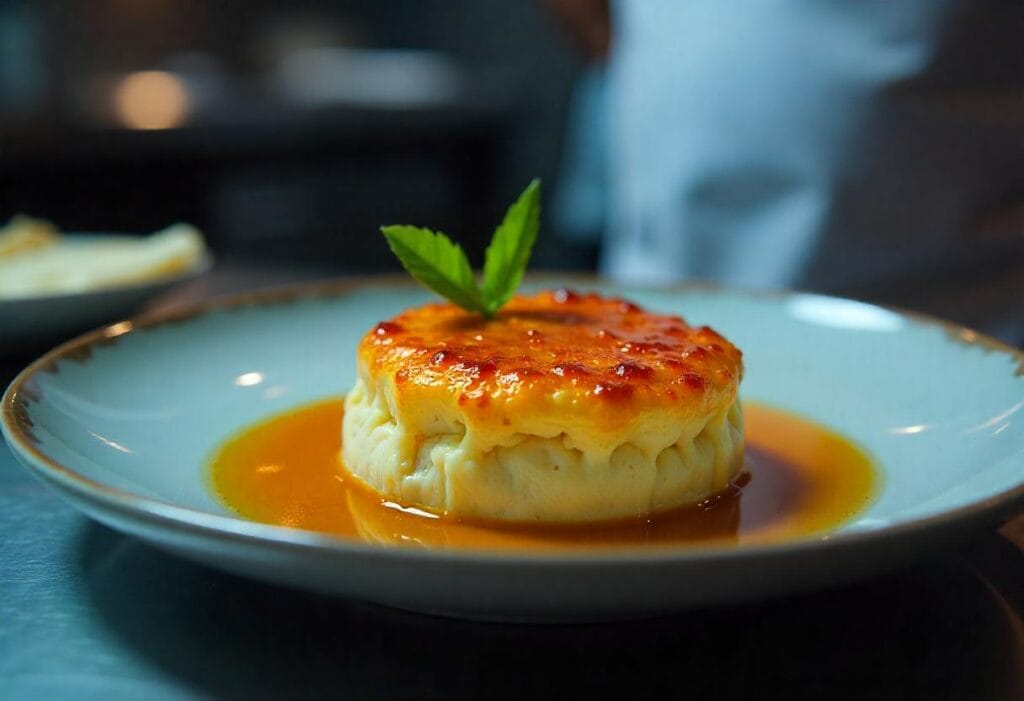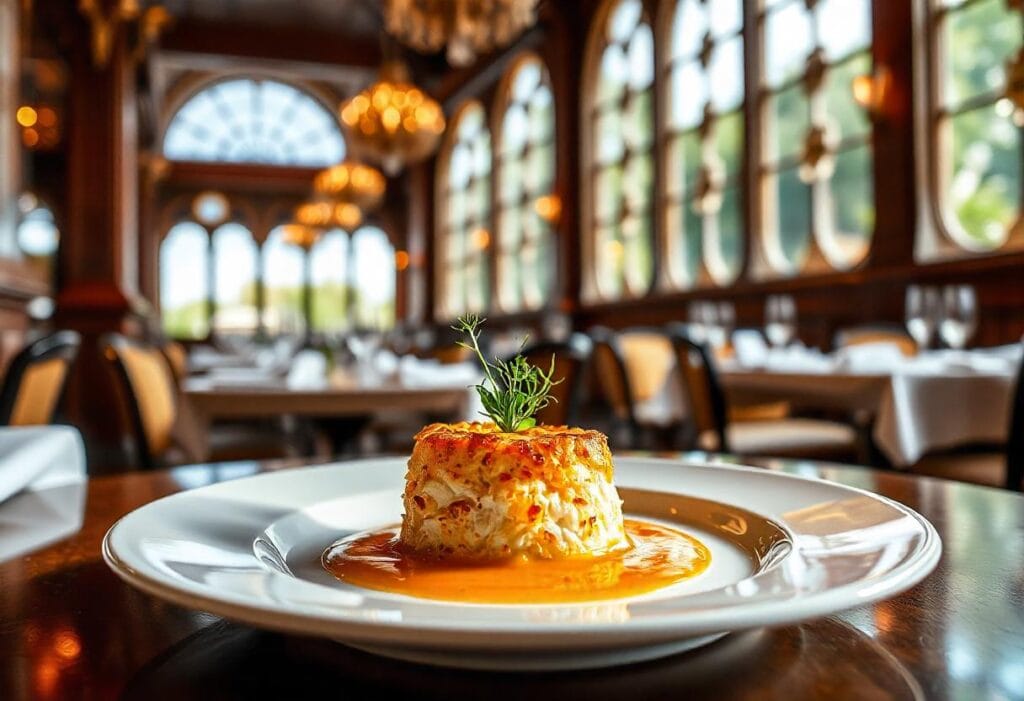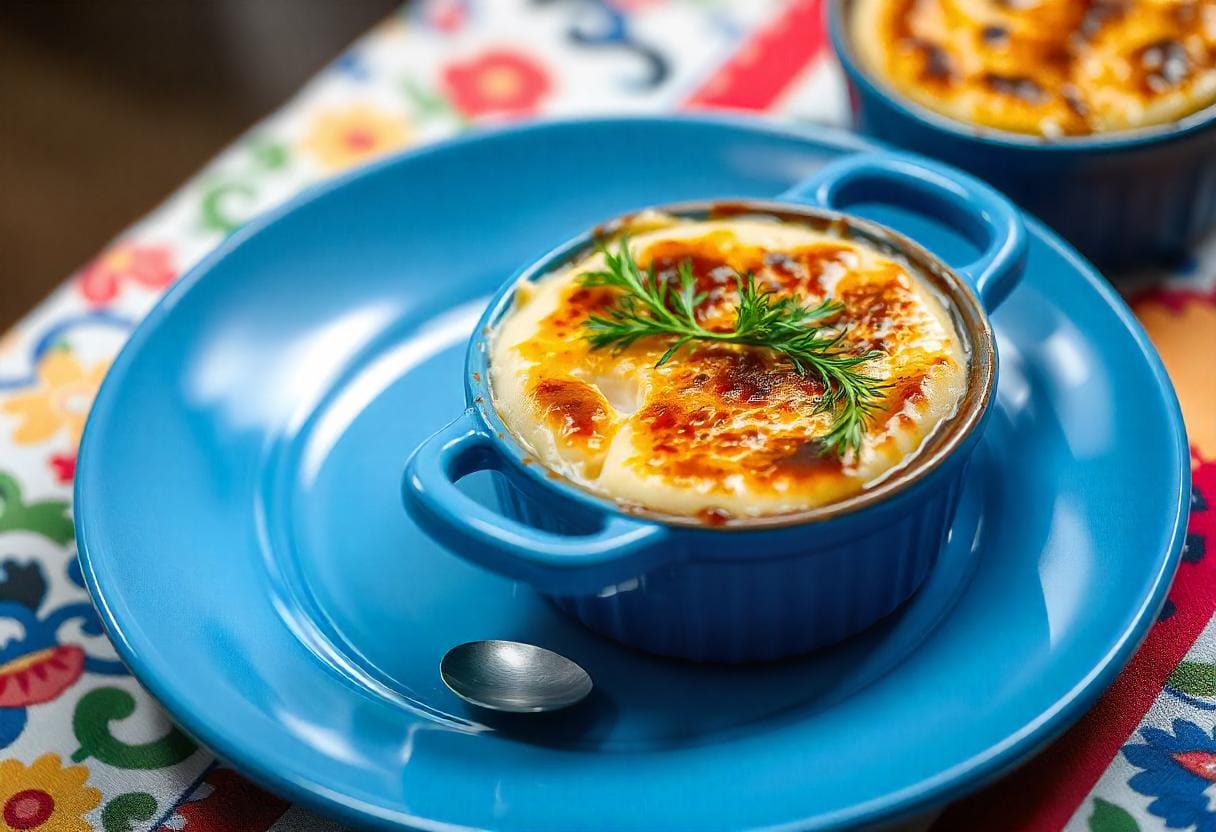Table of Contents
Crab brûlée is a luxurious and unique dish that blends creamy custard with delicate crab meat, creating a gourmet experience like no other. 🦀 But what exactly is crab brûlée, and why has it captured the hearts of food lovers everywhere? This guide explores the origins, ingredients, and step-by-step process of making this savory delicacy.
Crab brûlée is a savory twist on the traditional crème brûlée. Instead of a sweet custard base, it features a rich, crab-infused cream mixture topped with a caramelized crust. This dish perfectly balances creamy and crunchy textures while offering a burst of umami flavor in every bite.
Why is crab brûlée so appealing? It’s elegant enough for special occasions but surprisingly simple to prepare at home. Whether you’re hosting a dinner party or treating yourself to something special, crab brûlée is sure to impress.
“Crab brûlée is not just food; it’s a culinary statement—bold, beautiful, and utterly irresistible.”
History of Crab Brûlée
The Origins of Brûlée and Its Evolution Into a Savory Dish
The word « brûlée » comes from the French term for “burnt,” referring to the caramelized sugar crust that tops traditional crème brûlée. This dessert dates back to 17th-century France, where it was a luxurious treat for the elite.
Over time, creative chefs began experimenting with savory versions of brûlée, substituting custard bases with ingredients like cheese, vegetables, and seafood. Crab brûlée emerged as a standout, blending the sophistication of French cuisine with the natural sweetness of crab meat.
The Role of Crab in Culinary Traditions
Crab has long been prized in coastal cuisines around the world. Its sweet, delicate flavor pairs beautifully with creamy sauces and custards, making it a natural fit for savory brûlée recipes. From the buttery Dungeness crab of the Pacific Northwest to the rich blue crab of the Atlantic, each variety brings its own character to the dish.
Ingredients Needed for Crab Brûlée
The secret to a great crab brûlée lies in using fresh, high-quality ingredients. Here’s what you’ll need to get started:
Fresh vs. Imitation Crab: Which to Choose?
Fresh crab meat is always the best choice for flavor and texture. However, if fresh crab isn’t available, high-quality canned or frozen crab can work in a pinch. Avoid imitation crab, as it lacks the rich, natural taste needed for this dish.
Essential Ingredients for the Perfect Crab Brûlée
| Ingredient | Quantity | Purpose |
|---|---|---|
| Fresh crab meat | 1 cup | Provides the savory base flavor |
| Heavy cream | 1 cup | Adds richness and creaminess |
| Egg yolks | 3 large | Creates a custard-like texture |
| Parmesan cheese (grated) | ¼ cup | Enhances the savory flavor |
| Shallots (minced) | 2 tablespoons | Adds a mild onion flavor |
| Garlic (minced) | 1 clove | Boosts the overall depth of flavor |
| Butter | 1 tablespoon | Used for sautéing shallots and garlic |
| Salt and pepper | To taste | Balances and enhances the dish’s flavors |
| Sugar | 1 teaspoon | Caramelizes to form the brûlée crust |

Tools and Equipment You’ll Need
Having the right tools can make preparing crab brûlée a breeze.
Must-Have Kitchen Tools for Crab Brûlée
- Ramekins: Individual-sized dishes perfect for serving brûlée.
- Blowtorch: Essential for caramelizing the sugar topping.
- Mixing bowls: For combining ingredients smoothly.
Optional Tools for Professional Presentation
- Fine-mesh strainer: Ensures a silky custard by removing lumps.
- Kitchen scale: Helps measure ingredients precisely.
“Great tools don’t just make cooking easier—they make it feel like an art form.”
Step-by-Step Guide to Making Crab Brûlée
Ready to dive into this gourmet adventure? Follow these steps to create a perfect crab brûlée.
Step 1: Preparing the Crab Mixture
- Heat butter in a skillet over medium heat.
- Sauté minced shallots and garlic until fragrant, about 2 minutes.
- Stir in the crab meat, season with salt and pepper, and cook for 1–2 minutes. Set aside to cool.
Step 2: Creating the Creamy Base
- In a mixing bowl, whisk together egg yolks and heavy cream until smooth.
- Add grated Parmesan cheese and the sautéed crab mixture, stirring until well combined.
Step 3: Assembling and Baking the Brûlée
- Preheat your oven to 325°F (165°C).
- Divide the crab mixture evenly among the ramekins.
- Place the ramekins in a deep baking dish and fill the dish with hot water until it reaches halfway up the sides of the ramekins.
- Bake for 25–30 minutes or until the custard is set but still slightly jiggly in the center.
Step 4: Achieving the Perfect Caramelized Top
- Sprinkle a thin, even layer of sugar over each brûlée.
- Use a blowtorch to caramelize the sugar until it forms a golden crust.
Common Mistakes When Making Crab Brûlée
Even the most experienced cooks can encounter challenges when preparing crab brûlée. Here’s a breakdown of common pitfalls and how to avoid them.
Overcooking or Undercooking the Brûlée
Cooking the brûlée for too long can cause it to become rubbery, while undercooking leaves it runny and underwhelming.
Solution:
- Keep an eye on the custard while it bakes. It should be set around the edges but still have a slight jiggle in the center.
- Use an oven thermometer for accurate temperature control.
Balancing Flavors: Avoiding Too Sweet or Too Savory
Adding sugar to create the brûlée topping might seem odd for a savory dish, but it’s essential for the signature caramelized crust. That said, too much sugar can overpower the delicate crab flavor.
Solution:
- Stick to a light layer of sugar, just enough to create a crust without overwhelming the savory base.
- Adjust seasoning in the custard to ensure the crab flavor shines through.
Preventing a Watery Texture
A watery custard is a common issue, often caused by excess liquid in the crab meat or improper mixing.
Solution:
- Drain and pat dry the crab meat before incorporating it into the custard.
- Whisk the cream and egg yolks gently to avoid overmixing, which can create bubbles and affect the texture.
“Cooking is all about balance—too much or too little of any ingredient can tip the scales from perfection to disaster.”
Tips for Perfect Crab Brûlée
Mastering crab brûlée requires a mix of technique and finesse. These tips will help you achieve flawless results.
Choosing the Right Type of Crab
- Fresh Crab: Always the best option for flavor. Look for bright, firm meat with no fishy odor.
- Canned Crab: A convenient alternative, but opt for high-quality brands labeled “lump” or “jumbo lump” for the best texture.
The Importance of Using Fresh Ingredients
Fresh ingredients elevate the flavor of your brûlée, turning it from good to extraordinary. In addition, avoid pre-grated Parmesan, as it often contains anti-caking agents that affect texture
- Use fresh cream and eggs to ensure a rich, smooth custard.
- Avoid pre-grated Parmesan, as it often contains anti-caking agents that affect texture.
Mastering the Torch Technique for a Crisp Top
A blowtorch isn’t just a fancy tool—it’s the key to a perfect brûlée crust.
- Hold the torch a few inches above the sugar and move it in a circular motion to avoid burning one spot.
- Wait a few minutes after caramelizing to let the crust harden fully before serving.
“The crust is the crown jewel of crab brûlée—it should be crisp enough to crack with a spoon but never burnt.”
Variations of Crab Brûlée
One of the best things about crab brûlée is its versatility. Here are some creative variations to try.
Spicy Crab Brûlée
Add a kick to your brûlée by incorporating heat:
- Mix a pinch of cayenne pepper or a splash of hot sauce into the custard.
- Garnish with thinly sliced red chilies for a bold presentation.
Mini Crab Brûlée Appetizers
Perfect for parties, mini crab brûlées are served in smaller ramekins or even spoons for a bite-sized treat.
- Bake as usual but reduce the baking time to 15–20 minutes.
- Serve on a platter with crackers or toast points for dipping.
Keto-Friendly Crab Brûlée
Make your dish low-carb by skipping the sugar crust and adding keto-friendly ingredients:
- Replace heavy cream with full-fat coconut cream for a dairy-free twist.
- Use unsweetened almond flour to create a savory, crunchy topping.
Presentation Tips for an Elegant Plating
- Use small ramekins to create individual portions for each guest.
- Garnish with fresh herbs like dill or parsley for a pop of color.
- Serve on a decorative plate with a few lemon wedges for added flair.
“A beautifully plated dish doesn’t just feed the stomach—it feeds the soul.”
Exploring the Unique Appeal of Crab Brûlée
Crab brûlée is not just a dish—it’s a sensory journey. From the first crack of the caramelized crust to the creamy, crab-infused custard beneath, every bite is an experience. But what makes this dish stand out from other seafood creations? Let’s dive into the elements that set crab brûlée apart.
The Perfect Blend of Textures
One of the hallmarks of crab brûlée is its contrasting textures. The crisp, sugary topping creates a satisfying crunch, while the custard is smooth and velvety. Add in the tender flakes of crab, and you have a dish that delights your palate with every bite.
Pro Tip: Use a fine layer of sugar for the brûlée topping to ensure an even, golden crust without overpowering the custard.
A Fusion of Flavors
Crab brûlée is the perfect marriage of sweet and savory. The natural sweetness of crab pairs beautifully with the creamy base, while the caramelized sugar topping adds depth and complexity. A hint of Parmesan cheese or garlic can enhance the savory profile even further.
« Crab brûlée is like a symphony where each ingredient plays its part perfectly, creating harmony on your plate. »
The Elegance of Individual Portions
Serving crab brûlée in individual ramekins elevates its presentation, making it ideal for formal dinners or special occasions. The personal-sized portions feel indulgent, yet they’re easy to prepare and serve.
Creative Garnishes for Crab Brûlée
Garnishes can transform a simple dish into a gourmet masterpiece. Here are some ideas to elevate the look and taste of your crab brûlée:
- Herbs: Sprinkle fresh dill, parsley, or chives on top for a burst of color and flavor.
- Citrus Zest: Add a hint of grated lemon or orange zest to brighten the dish.
- Edible Flowers: Use blossoms like nasturtiums or pansies to create an elegant presentation.
- Microgreens: A small handful of microgreens adds a modern, restaurant-worthy touch.
Pro Tip: Garnishes should complement, not overpower, the dish. Choose simple, fresh options that enhance the natural flavors.

Seasonal Variations of Crab Brûlée
Crab brûlée is versatile enough to adapt to seasonal ingredients, allowing you to customize it throughout the year.
Spring and Summer
- Add Fresh Vegetables: Incorporate sautéed asparagus tips or sweet corn kernels into the custard for a fresh, light twist.
- Use Citrus: Enhance the custard with a splash of lemon juice or zest to brighten the flavor.
Fall and Winter
- Add Spice: Include a dash of nutmeg or cayenne pepper for warmth and complexity.
- Incorporate Root Vegetables: Fold in roasted butternut squash or parsnips for a hearty, seasonal variation.
“Seasonal ingredients keep crab brûlée exciting, offering a new twist every time you make it.”
Pairing Crab Brûlée with Other Dishes
Crab brûlée can be the star of your meal or a luxurious addition to a multi-course menu. Here’s how to pair it perfectly:
As an Appetizer
- Pair it with a light green salad drizzled with citrus vinaigrette for freshness
- Pair with a selection of artisan bread or crackers for dipping.
As a Main Dish
- Complement with a side of roasted vegetables, such as asparagus or Brussels sprouts.
- Add a creamy risotto or truffle mashed potatoes for a decadent pairing.
The Art of Plating Crab Brûlée
Plating is where your creativity can shine. A well-presented dish enhances the dining experience and makes your creation unforgettable.
Layering the Elements
- Start with a decorative plate to frame the ramekin.
- Add a small side garnish, such as a lemon wedge or edible flowers, for visual appeal.
- For a professional look, smooth the custard’s surface with a spoon before caramelizing.
Color and Contrast
- Use bright garnishes to contrast with the golden brûlée crust.
- Serve with colorful accompaniments like roasted red peppers or vibrant microgreens.
Why Crab Brûlée Makes a Memorable Dish
Crab brûlée is more than just a recipe; it’s a statement. Its unique blend of textures, flavors, and presentation make it a dish that people remember long after the meal is over. Whether you’re hosting a special occasion or looking to elevate your everyday cooking, crab brûlée is the perfect choice.
“Cooking is about creating memories, and nothing creates memories like a dish as elegant and delicious as crab brûlée.”
Frequently Asked Questions About Crab Brûlée
Let’s tackle some common questions to ensure your crab brûlée turns out perfectly every time.
Can Crab Brûlée Be Made Ahead of Time?
Yes! Prepare and bake the brûlée ahead of time, but wait to caramelize the sugar topping until just before serving to keep it crisp.
How Do You Store and Reheat Crab Brûlée?
Store leftovers in an airtight container in the refrigerator for up to 2 days. Reheat gently in a low oven (300°F) before adding the sugar topping and caramelizing.
What’s the Best Type of Crab for This Dish?
Fresh lump crab meat is ideal, but high-quality canned crab can work if fresh isn’t available. Avoid imitation crab for the best flavor.
Conclusion: The Irresistible Appeal of Crab Brûlée
Crab brûlée isn’t just a dish—it’s a culinary experience. With its creamy custard, savory crab flavor, and caramelized topping, it’s a recipe that delivers elegance and indulgence in every bite. Whether you’re hosting a dinner party or simply treating yourself, this dish is sure to leave a lasting impression.
“Crab brûlée is proof that sometimes, the most unexpected combinations create the most unforgettable flavors.”

